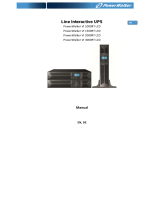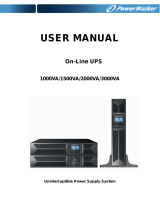Page is loading ...

ENGLISH
Quick Guide
PowerWalker VI (E)RT HID Series
I. Assembly
The UPS can be assembled in a rack form using rack ears (Rack Mount Kit is not included) or in
tower form using tower holder. The LCD part can be taken out and turned 90 degrees to align
with orientation of the UPS.
Internal batteries are disconnected for transportation. It is necessary to open front panel (2
screws on the side, 1 screw behind the LCD) and connect the two available connectors before
first usage. External batteries are connected in front using third connector.
Details at https://support.powerwalker.com/kb/faq.php?id=83 (faq.powerwalker.com)
II. Display Panel
The LCD uses blue back-light as standard. In case of critical error the
back-light changes to red. Buttons react to:
Click – Press the button for around 1s and release
Press – Press and hold for more than 3s, release
Press long – Press and hold for more than 10s, release
Control
Button
Switch
Function
ON/OFF
Press to turn on or off the UPS.
Press to release the UPS from faulty mode
Cut off input power and then press to shut down the UPS.
Test
Alarm
Silence
Press the button to perform basic function test
Press long to to perform battery life test
Click to disable alarm buzzer
Select
Press the Select button to select the settings value one by one
Enter
Press to enter settings mode
Click to enter settings item (settings string will flash)
Click to confirm settings
Press to exit Settings mode
III. Description of LCD display function
No.
Description
Function
Input frequency and
voltage
Indicates the value of input frequency and voltage
Input plug indicator
Lights on when the input power is at no loss.
Output frequency and
voltage
Indicates the value of output frequency and voltage
Output plug indicator
The UPS has two groups of outlets. The output plug
indicator will light on if there is output power
respectively.

ENGLISH
UPS status/user setting
display String
Strings Indicate the UPS status( see Table 4)
Strings Indicate user setting options( see Table 5)
Warning indication
Lights on when the UPS is failure or alarm.
Settings
Lights on when the UPS under settings mode.
Battery volume level
display
Indicates the amount of battery volume remaining.
Each battery volume level bar indicates approximately
20% of total battery volume
Load Power level display
Indicates the load level of the UPS. Each level bar
indicates approximately 20% of the total UPS output
Power.
IV. Rear Panels
VI 1000 ERT
1. AC Output
2. Network Surge
Protection
3. Intelligent Slot
4. AC Input
5. RS232 / Dry-
Contact Port
6. USB Port
7. EPO
8. Grounding
VI 1000 RT and VI 1500 RT
VI 2000 RT
1. AC Output
2. Network Surge
Protection
3. Intelligent Slot
4. Fan
5. AC Input
6. RS232 / Dry-
Contact Port
87651
2 431
NETWORK/TELEPHONEP ROTECTION
INPUT 2 20-240V~
INTERFACE OPTI ON
EPO
USBRS232
OUTIN
LS2 OUT P UT
25KV~ 10 A
LS1 OUT PU T
25KV~ 1 0A
LS1 OUT PUT
25KV~ 10A
LS2 OUT PUT
25KV~ 10A
1
4
1
3
7
5
6
8 9
2
IN OUT
NETWORK/TELEPHONE PROTECTION
INTERFACE OPTIO N
EPO
USB
RS232
INPUT 220-240 V~

ENGLISH
VI 3000 RT
7. USB Port
8. EPO
9. Grounding
V. Communication Ports
A Local communication with the software can be
established via USB or RS232 cable. RS232 connector
alternatively offers dry contacts for potential free signals.
VI. DB9 Female (RS232 + dry contact) pin
description
PIN #
Description
I/O
Function Explanation
1
BATLOW
Output
Battery low
2
RXD
input
RXD
3
TXD
Output
TXD
4
DTR
Input
N/A
5
Common
--
Common (tied to chassis)
6
DTR
Input
N/A
7
RING
Output
Ring
8
LNFAIL1
Output
Line fail
Dry contacts are not available for VI ERT series.
VII. Extension Slot
UPS allows extending communication means by extension cards. Please check product
website for list of accessories.
VIII. UPS Initial Startup
6. Verify that the internal batteries (behind front panel) and optional battery packs are
connected.
7. Plug the equipment (load), but do not turn it on
8. Plug in the UPS input power cord. The UPS front panel display illuminates and UPS
status display shows “STbY”
9. Press and hold the ON/OFF button more than 3 seconds. The UPS status display
LS1 OUT PUT
25KV~ 10A
LS2 OUT PUT
25KV~ 10A
1
~
1 4
1
3
7
5
6
8 9
2
25KV 16A
IN OUT
NETWORK/TELEPHONE PROTECTION
INTERFACE OPTI ON
EPO
USB
RS232
INPUT 220-240V ~

ENGLISH
changes to “NORM”
10. Configure the UPS (i.e. EBM battery settings)
At initial startup, the UPS sets system frequency according to input line frequency.
IX. User Setting String
OPV
Output voltage mode select
220/230/240 (value in Volt)
AVR
Input type select
[000]= Normal range mode
[001]= Wide range mode
[002]= Generator mode
EbM
External battery modules
0-9 (quantity of external BPs)
TEST
Auto self-test
[000]=Disable [001]=Enable
AR
Automatic restart
[000]=Disable [001]=Enable
GF
Green function
[000]=Disable [001]=Enable
bZ
Buzzer control
[000]=Disable [001]=Enable
LS1
Load segment 1
[000]=Turn off [001]=Turn on
LS2
Load segment 2
[000]=Turn off [001]=Turn on
X. Operating Mode
Normal range mode: the UPS accepts AC input voltage range for +/-20%.
Generator mode: the low frequency transfer point can go as low as 40Hz and as high
as 70Hz before being transferred to battery mode.
Wide range mode: the UPS accepts AC input voltage range for -30% ~ +20%.
XI. Configuring Load Segment
Load segments are groups of outlets that can be configured through the display. VI RT HID
models have two configurable load segments (excluding VI ERT HID). When UPS is turned
on (it has activated output), you can turn off a load segment. If the UPS is turned off (no
output), then a load segment cannot be turned on.
XII. Configuring EBM quantity
Setting correct EBM (External Battery Module) quantity is critical for reaching the desired
backup time. Only if this value is set correctly, UPS will be able to maximize the battery
usage. (VI ERT does not have battery modules). The value represents amount of original
battery packs fitted with 2 strings of 9Ah batteries.
XIII. Configuring Green Function
Green Function cuts off the load in battery mode if it detects insignificant load, for
example after PC has been safely shut down, the remaining current drain may come from
speakers or monitors. To allow working with small loads (i.e. routers) this function can be
disabled.
XIV. UPS Status Display String
LCD Display String
Description
STbY
UPS work at Standby mode
IPVL
Input voltage is too low
IPVH
Input voltage is too high
IPFL
Input frequency is too low

ENGLISH
IPFH
Input frequency is too high
NORM
UPS work at Line mode
AVR
UPS work at AVR mode
bATT
UPS work at Battery mode
TEST
UPS work at battery life/function test mode
OPVH
Battery mode, the output is too high
OPVL
Battery mode, the output is too low
OPST
Output short
OVLD
Overload
bATH
Battery voltage is too high
bATL
Battery voltage is too low
OVTP
Internal temperature is too high
FNLK
Fan is locked
bTWK
Batteries are weak
XV. Indicators and Audible alarm
Audible alarm
Backup Mode
Sounding every 4seconds
“bATT” on the screen
Low Battery
Sounding every second
“bATL” on the screen
UPS Fault
Continuously Sounding
Red display
Overload
Sounding every second
“OVLD” on the screen
Battery Replacement
Sounding every second
Alarm can be muted when it is activated, but it will sound in case of low battery, fan
fault, overheat and other major fault.
XVI. Technical Specification
Model
1000 ERT
1000 RT
1500 RT
2000 RT
3000 RT
Power
Watt
900W
900W
1350W
1800W
2700W
Input
Input voltage range
161-276VAC
Frequency range
50/60Hz ±5Hz for Normal Mode
40-70Hz for Generator Mode
Output
Voltage
220/230/240VAC
Voltage Regulation
±5% in battery mode
Frequency
50Hz or 60Hz
Waveform
Pure sinewave
Overload
rating
Line Mode
110% -0%, +8%: shutdown after 3 minutes.
150% -0%, +10%: shutdown after about 200ms
Battery Mode
110% ± 6%; shutdown after 30 seconds.
120 % ± 6 %; Shutdown after about 100ms
Internal
battery
Battery Power
(12V VRLA)
2 x 9Ah
3 x 7Ah
3 x 9Ah
6 x 7Ah
6 x 9Ah
Recharge Time to
90%
8 hours
3 hours
4 hours
3 hours
4 hours

ENGLISH
Temperature
0 to 40°C
Humidity
20%-80% relative humidity (non-condensing)
Altitude
<1500m
Storage Temperature
-15 to 45 C
Net weight
15.0kg
17.8kg
17.8kg
27.8kg
27.8kg
Dimensions
438 X 86.5 x 436
438 X 86.5 x 608
/







